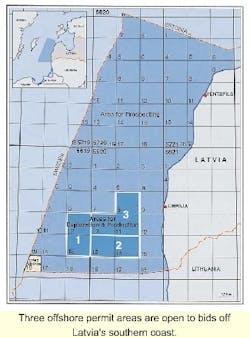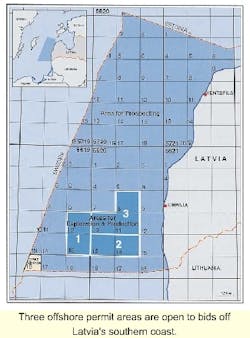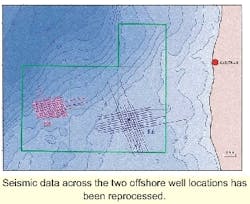WESTERN EUROPE: Latvia reviving exploration in shallow water Baltic basin
Latvia has initiated the first open offshore licensing in the former Soviet sector of the Baltic Sea. Bids have been invited for three permit areas covering 2,675 sq km, in water depths ranging from 30 meters to 130 meters. Exploratory drilling in these waters has been patchy, but there has been one minor oil discovery. Latvia is part of the Baltic sedimentary basin, which is a proven petro-liferous province.
At a recent presentation in London to launch the licensing round, Economy Minister Aigars Kalvitis cited a World Agency report that estimated potential oil deposits of 200 million tons in the Baltic region. Numerous hydrocarbon accumulations of varying size have been identified, mainly in Cambrian sandstone reservoirs.
Also, there are known carbonate reservoirs within the Ordovician and Silurian successions. According to Sergejs Kanev of the Latvian Geological Survey (LGS), most accumulations discovered in the sea and the adjoining coastal areas to date have been oil, although gas pools are being found increasingly offshore Poland.
Surrounding production
Among Latvia's neighbors, Lithuania produced 400,000 cu meters of oil last year, wholly from land-based fields. Kaliningrad province has produced oil from its onshore fields since 1975, and is currently outputting 900,000 cu m/yr. Kaliningrad is also considering joint development with Poland of the D6 offshore oil discovery on the median line between Poland and Russia. Poland's B3 offshore complex produced 300,000 cu meters of oil. There has also been modest production in the past from oil pools on Sweden's Gotland Island.
Exploration to date in Latvia has been predominantly onshore, leading to some minor discoveries. A short-lived attempt was made at small-scale oil production from the Kuldiga Field in the 1990s, but this proved to be uneconomic. However, LGS believes there is a high probability of finding larger commercial accumulations in the Latvian sector of the Baltic Sea, toward the central more-submerged part of the basin.
New exploration
No new exploration wells have been drilled on or offshore Latvia within the past decade. The most recent seismic acquisition program, over the western offshore area in 1991, led to identification of some fairly substantial leads, close to Swedish waters. One part of this area was licensed to the Amoco/OPAB consortium in 1996, but efforts to drill have been thwarted by the continuing offshore border dispute between Latvia and Lithuania.
Exploratory drilling in the Latvian Baltic started in 1976, and was conducted by CO Petrobaltic, at that time a group of companies representing East Germany, Poland, and the USSR. The consortium's activities were focused on the southern part of the offshore area, as far north as Liepaja. Farther north, all exploratory activity was managed by the USSR's Ministry of Oil Industry.
Between 1976 and 1989, 24,000 sq km of seismic was acquired offshore by the Baltic Geophysical Expedition, Minnefteprom. This identified numerous prospects, but only two were drilled by CO Petrobaltic. The E6 and E7 wells encountered the Cambrian sandstone with good reservoir properties, and E6 discovered a minor oil accumulation within the Ordovician succession. It flowed 4 bbl during a six-hour test.
The USSR also drilled a well in waters north of the currently available permits, but action was off-structure, Kanev said, and was designed largely to test new drilling equipment.
Selected offshore seismic data was repro-cessed by the Latvian Geological Survey in 1997, using Landmark's ProMax system. This was converted from the original Russian SEG-B storage format to the international SEG-Y format.
For the first offshore licensing round, a regional data package is available, which includes 1,145 km of seismic from 11 surveys. Following reprocessing, archive stacks are now presented as composite regional lines showing main structural elements in the Latvian sector of the Baltic basin, tying the offshore wells to various undrilled prospects. LGS is also offering 1,500 line km of seismic acquired over western onshore Latvia from 1985 to 1992. All the data has again been reprocessed using the ProMax system.
A mini-atlas, entitled "Latvia - Petroleum Potential and Exploration Opportunities," has been produced by LGS in association with Norway's PGS Reservoir. This includes information on the Baltic's geological history, stratigraphy and palaeogeography, reservoirs, and source rocks (available from Sergei Kanev, State Geological Survey of Latvia, Tel: +371 732 0034, e-mail: kanev at vgd.gov.lv).
The three offshore permit areas will be awarded for up to 30 years, including an exploration phase of up to five years. The Latvian state will hold a 10% share of all licenses on a carried basis during exploration/appraisal. Licensees will be subject to 25% corporate tax and a sliding scale of royalties, varying from 2% for oil production of up to 10,000 b/d to 12% for production beyond 80,000b/d.
According to Kalvitis, foreign investors will be given the same treatment as national companies, so there will be no restrictions on exports of capital. Latvia's infrastructure should also serve as an incentive to field developers. Kalvitis pointed out that 28% of Russia's oil heads to the west via Latvian ports.


